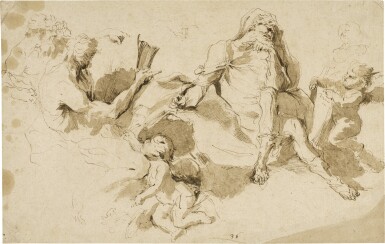
Giovanni Benedetto Castiglione, called Il Grechetto
Three Philosophers with Putti
Auction Closed
January 27, 09:35 PM GMT
Estimate
35,000 - 45,000 USD
Lot Details
Description
Giovanni Benedetto Castiglione, called Il Grechetto
Genoa 1609 - 1664 Mantua
Three Philosophers with Putti
Pen and brown ink and wash;
numbered in brown ink, lower centre: 36
253 by 399 mm; 10 by 15 5/8 in
by descent to Edward Holland, Mrs Rayner Wood, and Edward Holland-Martin;
sale of the Skippe Collection, London, Christie's, 20-21 November 1958, lot 71 (catalogue by A.E. Popham);
with P. & D. Colnaghi, London, 1959 (Old Master Drawings, 1959, cat. no. 22);
Wilfred Thesiger, London;
sale, New York, Sotheby's, 12 January 1990, lot 71;
with Eduardo Testori, Milan;
sale, London, Sotheby's, 7 July 1999, lot 42;
sale, London, Sotheby's, 10 July 2002, lot 133;
sale, London, Christie's, 6 July 2004, lot 65
A. Percy, 'A Castiglione Album,' Master Drawings, vol. 4, (1968), pp. 144 and 148, no. 10, pl. 41a;
Idem, Giovanni Benedetto Castiglione, Master Draughtsman of the Italian Baroque, Philadelphia, 1971, p. 72 under cat. no. 22
The expansively drawn, large sheet of studies belongs to a series of similarly executed drawings by Castiglione, all numbered in the same way, which probably originated from a single album. The link between the drawings was first noted by Felice Stampfle and Jacob Bean, and explored and described in more detail by Ann Percy, in her 1968 Master Drawings article (see Literature). Although Castiglione is perhaps best known as a draughtsman for his highly original, mixed-media colored works and his monotypes, drawings such as this demonstrate to the full his ability to create accomplished and dynamic works when using the more traditional media of pen and ink and wash.
Percy dated these drawings between the late 1640s and the early 1650s, and noted that they fell into four distinct groups, by subject-matter. They do not, however, generally relate to paintings by the artist, and may have been made simply as exercises in invention. Other drawings from the group are in major European and American museum collections.1 Particularly close to the present sheet, in terms of conception and style, are three works from the series in New York, Venice and Paris2, and another, recently exhibited, in the Royal Collection at Windsor Castle.3
For a point of the brush and oil study by Castiglione see lot 233
1. See Percy, op. cit., 1968, and op. cit., 1971, cat nos. 22-34
2. See Percy, op. cit., 1971, cat. nos. 23-25
3. RL 3924; see T.J. Standring and M. Clayton, Castiglione, Lost Genius, exh. cat., London, The Queen's Gallery, 2013, pp. 131, 133, cat. 73
